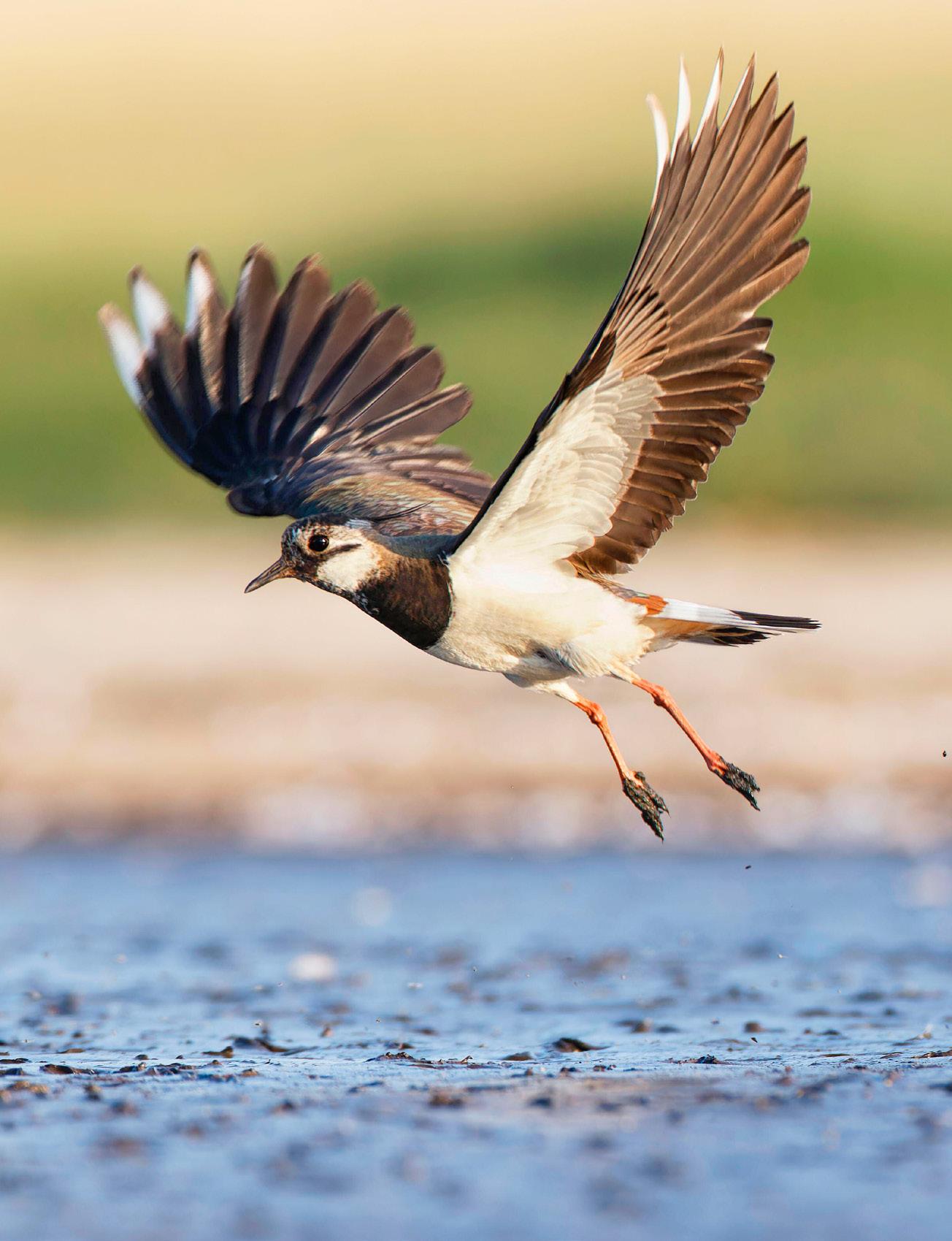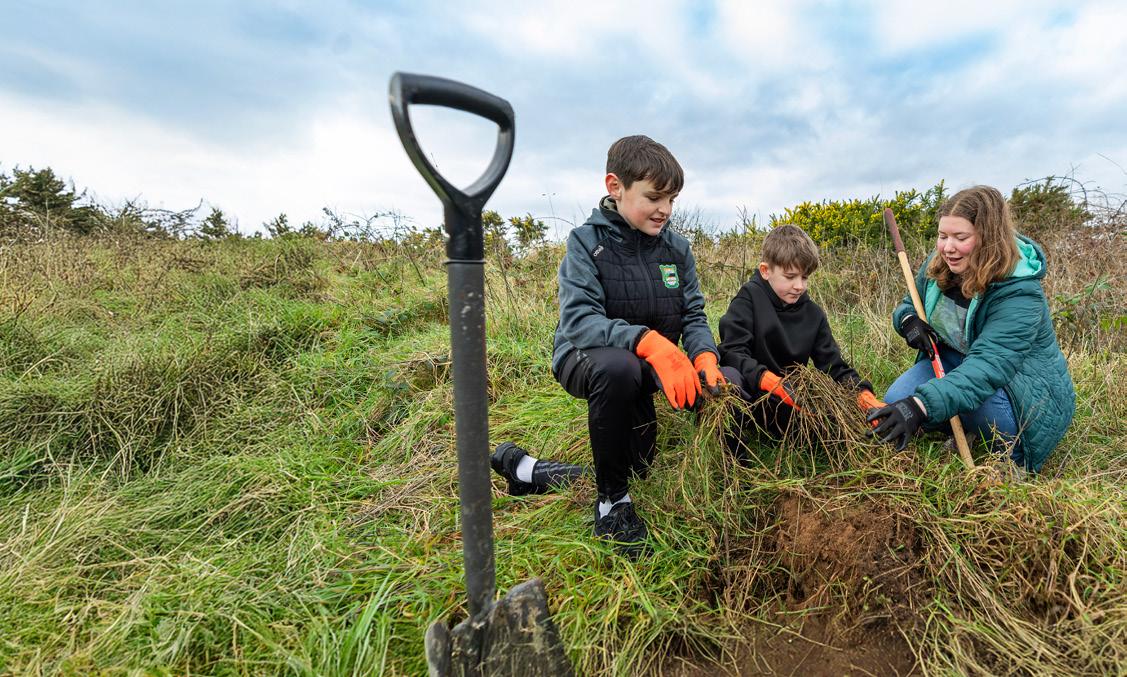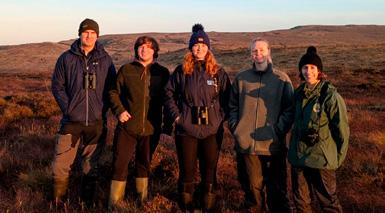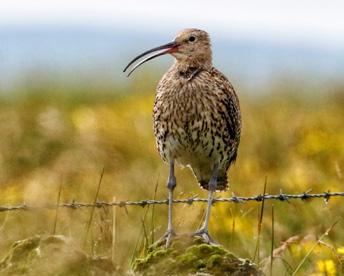Nature’s Voice
News from RSPB Northern Ireland and the Isle of Man


News from RSPB Northern Ireland and the Isle of Man

A project to rejuvenate Lough Erne will improve habitat for waders and other wildlife
How we’re helping the ‘lungs of the landscape’
Farming for nature
You’re using your voice to speak up for nature

Welcome to your Spring/Summer issue of Nature’s Voice, I hope this finds you well and ready for a new season of nature. I can’t wait to share the incredible work of our teams to protect and restore nature across Northern Ireland.
In this issue, we reflect on an incredible nine-year partnership of the Lough Erne Landscape Project (LELP), which ended in December (p6) and share an exciting update about peatland restoration with the launch of the new Peatland Programme (p2). You’ll get the chance to hear even more about our new Peatland Programme team in nature notes (p3).
This year, we have more opportunities for young people to get involved as we launch the RSPB NI Youth Network,with the hope of bringing a new generation of nature enthusiasts to the RSPB (p3).
As we get ready to reopen the West Light Seabird Centre on Rathlin Island for the season, we will be welcoming visitors from across the world to our ‘seabird city’. Our top tips will help you make the most of your visit (p8).
I hope you’ll find something of interest between these pages and take the opportunity to get involved in supporting nature this year. I look forward to seeing you out and about on our reserves.

Joanne Sherwood Director, RSPB NI
Northern Ireland’s peatlands, often hailed as the ‘spongy lungs of the landscape’, are a vital part of our natural heritage. These waterlogged ecosystems, characterised by their distinctive peat soils, play a crucial role in regulating water flow, storing carbon, and providing habitat for a diverse range of flora and fauna.
To safeguard these precious ecosystems, we’ve launched the Lowland Raised Bog Recovery Programme to restore raised bogs in the Bann Valley, South Lough Neagh and East Fermanagh. This ambitious initiative aims to breathe new life into these vital habitats by developing plans for up to seven
new restoration projects. With six new conservation officers on board, the team is ready to embark on these shovel-ready projects, covering an impressive 260 hectares.
Funded in partnership with the Esmée Fairbairn Foundation and the Department of Agriculture, Environment and Rural Affairs (DAERA), this comprehensive programme will not only create a pipeline of fully costed restoration projects but also educate landowners, communities and contractors about the benefits of peatland restoration. By inspiring and engaging people, RSPB NI hopes to encourage widespread participation in this essential work.

Do you care about nature and want to make a difference? Or do you know someone who might like to get involved?
RSPB Northern Ireland has a variety of opportunities to take action for nature, whether it’s volunteering on a nature reserve, undertaking practical conservation work or taking photographs to showcase the valuable work the RSPB is doing. Volunteering is a fantastic way to meet new people, have new experiences and learn new skills.
The RSPB is also calling for young people aged 18–24 to join the new Youth Network for Nature. As a member of the Youth Network, you’ll play an essential part in conserving nature. From supporting conservation activities to collaborating to organise events, you’ll contribute to exciting initiatives that help nature. Email nivolunteers@rspb.org.uk – we can’t wait to hear from you.


Meet the new Peatland Programme team
The new Peatland Programme team is dedicated to restoring Northern Ireland’s peatlands. Led by Programme Manager Martin Clift and Project Manager Maria Mulholland, the team includes Peatland Officers Tom McMurray, Sarah West and Niamh Dornan. They will work closely with landowners, farmers and local communities to implement sustainable management practices that enhance biodiversity and mitigate climate change by restoring these vital ecosystems.
In September last year, the RSPB launched a petition calling on the UK Government to invest in naturefriendly farming. This has gained widespread support across the UK, and we are delighted that over 1,600 people in Northern Ireland have already signed it, speaking up collectively in favour of helping farmers to help nature.
The petition was backed by farming groups such as the Nature Friendly Farming Network, Pasture for Life, Rare Breed Survival Trust and Landworkers’ Alliance, as well as individual farmers across Northern Ireland.
RSPB NI will continue campaigning for increased investment and support for nature-friendly farming practices in Northern Ireland.


Last Winter, RSPB NI embarked on a vital restoration project on Rabbit Island, County Fermanagh, as part of Curlew LIFE. The team created a more welcoming environment for ground-nesting birds like Curlews (above) by carefully removing scrub and trees. Opening up the landscape reduces predator hiding spots and creates space for birds to feed and raise their young. We’re looking forward to seeing what difference this makes during breeding season.
There’s a certain magic about waking up before the dawn, the world still and quiet. But, as the first light begins to paint the sky, a symphony of bird song erupts, a chorus of chirps, trills and whistles that fills the air with life. It’s a breathtaking experience and we encourage anyone to rise with the birds and spend a moment in nature. It’s a unique reminder of the wonder of the natural world. So, this year set your alarm for International Dawn Chorus Day on Sunday 4 May and experience it for yourself.


Our people
Nature Neighbourhoods, a collaborative project funded by the Co-op and the National Lottery Community Fund, is empowering communities to lead nature and climate action.
In Northern Ireland, the project is supporting Ligoniel Improvement Association and EastSide Greenways. Ligoniel is inspiring residents to connect

A small, sparrow-like bird with a distinctive black head and bib in males (pictured). Females are more subtly coloured, with a streaked brown back and pale underside. Often found near water bodies, particularly reed beds, where they forage for seeds and insects. Their melodious song, a series of warbles and trills, is common in wetland habitats. Reed Buntings are resident here in the UK and can be seen all year round, while some may join us from Scandinavia for the winter.
This year, RSPB NI showcased a unique look at peatlands as part of the NI Science Festival, with guest speaker and RSPB Ambassador Lucy Hodson, also known as Lucy Lapwing, hosting an informative talk at the Ulster Museum.
With her infectious enthusiasm, Lucy delved into the vital role of peatlands, emphasising their importance as carbon sinks and biodiversity hotspots. The talk was both informative and entertaining, leaving attendees with a new-found appreciation for these unique ecosystems and the intricate world of peatlands.
with local wildlife through nature walks and events, while EastSide Greenways is empowering residents to shape their neighbourhood’s sustainable future.
With RSPB NI’s support, these communities are creating bespoke plans to address their unique needs, reduce barriers to nature and inspire hope for a greener future.

Scientific name Emberiza schoeniclus
Wingspan 21–28cm
Length 15–16.5cm
Where to see Urban and Suburban, Farmland, Wetland, Grassland
Conservation status Not assessed


Allison Leonard, Managing Director Manx BirdLife
Manx BirdLife is celebrating a remarkable milestone at the Point of Ayre National Reserve: the recording of its 200th bird species!
This exciting achievement occurred in early November when Reserve Manager David spotted an Avocet gracefully feeding at the reserve’s northern edge. Easily identified by its distinctive upturned bill, the Avocet (pictured) was observed for around 10 minutes before flying westwards.
Fortunately, a group of birdwatchers spotted it again the following day before it disappeared once more, with the bird now thought to be roosting in the south of the island. This sighting is significant, not only adding a new species to the reserve’s impressive list but also highlighting the crucial role the Point of Ayre plays in
supporting diverse wildlife. The Avocet’s presence underscores the importance of this habitat as a sanctuary for both migratory and resident birds.
With continued conservation and restoration efforts, there’s even hope that this elegant species could one day join the island’s breeding bird list.

I’m looking forward to my first trip to Rathlin Island when the Seabird Centre reopens, but I wondered, when is the best time to visit to see the Puffins?
Otis, Newtownards

The best time to see Puffins at Rathlin Island is typically from late April to early July. This is when they arrive to breed and raise their young. You’ll have the best chance of seeing them in their full breeding plumage, with their colourful beaks and distinctive appearance. See the back page for some ideas on how to spend a day on the Island.
I see Red Kites soar near my house – do I need to report the sightings? How do I go about this?
Cathy, Newcastle

It’s amazing to hear that you’ve spotted Red Kites in your area, and if you can report sightings then it really helps RSPB NI understand how Red Kites are faring in Northern Ireland. Please email redkiteni@rspb.org.uk and include as much detail as possible, including the location, time and any distinguishing features or tag colours you can see. The more information you can provide, the more accurate the data will be.
I’m hoping to put some bird boxes up in my garden ahead of breeding season. Where is the best place for them to go?
Clive, Bellaghy

Choose a sheltered spot away from direct sunlight, and make sure it’s a decent height off the ground. It’s important to consider the type of bird you want to attract, as different species have different preferences. You can find out more at rspb.org.uk/helping-nature
Find out more To discover more about the impactful work of the Lough Erne Landscape Partnership and explore the rich heritage of this stunning region, visit lelp.org.uk
The success of the Lough Erne Landscape Partnership, a five-year journey to restore this diverse habitat, shows the huge potential for nature when we work together
Lough Erne, nestled in the heart of County Fermanagh, is a natural wonder of breathtaking beauty. Its tranquil waters, dotted with countless islands, provides a vital habitat for a diverse array of flora and fauna. The lough’s mosaic of habitat, from open water and reedbeds, to woodlands and grasslands, provides a haven for a rich variety of wildlife.
Recognising the importance of this unique environment, the Lough Erne Landscape Partnership (LELP) brought together a diverse group of organisations, including Fermanagh and Omagh District Council, Fermanagh Rural Community Network, Lough Erne Heritage, the National Trust, Upper Lough Erne Region, and Waterways Ireland, to deliver £2.5 millionworth of projects funded by The National Lottery Heritage Fund.
Over the last five years, work took place to safeguard and celebrate the distinctive built, natural and cultural heritage of Lough Erne and its surrounding communities and provide a legacy for future generations.
Thanks to this partnership and funding, over 87,000 visitors accessed new nature trails, 49,000-plus people engaged with events and more than 3,300 people got
involved in volunteering across the landscape. Below, you can read more about some of these incredible projects that were supported by RSPB NI and made a real difference to nature and the local community.
The Lough Erne Landscape Programme officially closed at the end of December and celebrated an incredible achievement of delivering 46 communitybased projects that tackled a range of ecological issues, rekindled local connections to heritage, stimulated economic and social growth, and forged some valuable partnerships.
Restoring a wader’s paradise
Lough Erne is home to a diverse range of wildlife. However, some bird species such as Curlew, Lapwing, Snipe and Redshank have experienced declining breeding numbers over recent years. In the hopes of
‘This restoration not only benefited the waders but also the overall biodiversity. As the iconic birds thrive, so too will the delicate ecosystem’



46
halting or reversing this trend, a project was launched to restore the islands of Lower Lough Erne and transform them into ideal breeding grounds. These islands, once used for grazing livestock, had become overgrown with trees and shrubs, making them unsuitable for waders.
community, and celebrating the success of the initiative. By bringing people together, the Wellness Through Nature project not only promoted protection of our feathered friends but also enriched the lives of those who participated.
53,765
87,000
49,000
196 community-led projects hours of volunteer time visitors accessed nature trails community-led projects new partnerships
LELP in numbers Get involved...
Working with RSPB NI and Countryside Land Management Services (CLMS), work began to remove invasive vegetation and open up the landscape to create the perfect conditions for these species to nest and raise their young. Meanwhile, a grazing regime involving highland cows and ponies helped maintain the open grassland and prevent it from becoming overgrown again.
This restoration not only benefits the waders but also contributes to the overall biodiversity of the region. As these birds thrive, so too will the delicate balance of the Lough Erne ecosystem.
The Wellness Through Nature project, supported by the Arts Council of Northern Ireland and the National Lottery Heritage Fund, aimed to foster a deeper connection between people and the stunning landscape of Lough Erne.
A key focus was the conservation of endangered wading birds, including the iconic Curlew, Snipe and Lapwing. These magnificent creatures face numerous threats, from habitat loss to predation. By raising awareness and educating local communities, the project sought to inspire action to protect these vulnerable species.
Through a series of community art workshops, participants explored the beauty and the fragility of the Lough Erne environment, including local artist Kevin McHugh, who created a stunning painting that captures the essence of the waders and their habitat.
The project culminated in three large-scale exhibitions, showcasing the creative work of the
RSPB NI hopes to continue maintaining the partnerships forged through the project to ensure its lasting legacy. We will do this by continuing to engage with the Lough Erne community needs, and fostering wider cohesion to ensure a positive and longlived impact, working together to protect and conserve nature in the local area.
Seamus Burns, Area Manager RSPB NI, shares his gratitude to the LELP team: “I want to commend the award-winning Lough Erne Landscape Partnership Team – Hazel Long, Ashley Robinson, Eamonn Fitzgerald and Janice Marsden (and to all previous LELP staff) who were led by Elmarie Swanepoel. We have been humbled and privileged to witness their passion for this landscape and its communities and their determination to deliver the best possible impact.”
Help us protect Northern Ireland’s wildlife by volunteering with RSPB NI. Opportunities range from hands-on habitat management and species monitoring to engaging with the public at events or through online platforms. Share your skills and passion for nature to make a real difference for birds and their habitats. rspb.org.uk/volunteering
Discover more about the delights of Rathlin Island in our feature about it in The RSPB Magazine
This scenic habitat is internationally important for breeding seabirds and is home to Northern Ireland’s largest seabird colony. Here’s how to get the most out of your visit

Explore seabird city at West Light Seabird Centre
Craggy cliffs meet crashing waves at the West Light Seabird Centre, where you can learn about the seabirds you might see. The cliff faces are open to the Atlantic Ocean, providing the ideal place for Puffins (pictured), Guillemots, Kittiwakes, Razorbills and Fulmars. Visit from late April to early July for views of Puffins and other seabirds as they gather in their thousands to rear their chicks.
Contact us
RSPB Northern Ireland Headquarters
Belvoir Park Forest, Belfast BT8 7QT 028 9049 1547 rspb.nireland@rspb.org.uk
Follow us facebook.com/RSPBNI twitter.com/RSPBNI @rspb_ni

See a unique marvel on Rathlin Island
Rathlin Island’s West Light, also known as the ‘upside-down lighthouse’, has been guiding boats to safety for more than 100 years. This fascinating landmark offers a glimpse into the ingenuity of maritime engineering. It’s a must-see for anyone interested in lighthouses or maritime history, or simply seeking a unique and picturesque destination.

Hit the trail at RSPB Roonivoolin Reserve
Take the route less travelled on Rathlin Island and venture south to the Roonivoolin Trail, with amazing views of the cliffs, Church Bay and the dramatic Northern Ireland coastline. Listen out for the incredible wildlife that you could spot along the way, including Grey Seals, Irish Hares (pictured) and Curlews. Keep a keen eye out for beautiful wildflowers, like Heath Spotted-orchid.
Antrim
Brenda Campbell, 028 9332 3657 group.rspb.org.uk/antrim
Belfast
Eleanor Brennan, group.rspb.org.uk/belfast
Coleraine
James McDowell, 07596 503 435 group.rspb.org.uk/coleraine
Fermanagh
Rosalind McConkey, 028 6632 0794 group.rspb.org.uk/fermanagh
Lisburn
Ian Raine, group.rspb.org.uk/lisburn

Enjoy the wildflowers on the Craigmacagan Walk
A short distance from the harbour is the Craigmacagan Walk. In May, the fields are filled with Bluebells and orchids, with views across to Scotland on a clear day. Easily walked, this short trail offers the chance to see another side of the island, with plenty of flora, fauna and birds to see along the way.